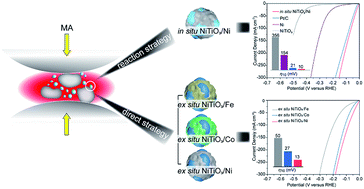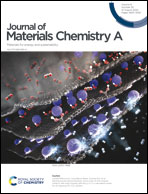Mechanically alloyed NiTiO3/transition metal heterostructures: introducing oxygen vacancies for exceptionally enhanced hydrogen evolution reaction activity†
Abstract
Hydrogen, a clean and renewable energy carrier, is a promising alternative energy resource to replace fossil fuels. Among various hydrogen production methods, water electrolysis is a sustainable approach to gain pure hydrogen in useful amounts, but its use is still limited by the lack of efficient and low-cost electrocatalysts. Here, a convenient and straightforward mechanical alloying (MA) process is reported that can be used to produce heterostructured catalysts with good performance for the hydrogen evolution reaction (HER). A NiTiO3/Ni hybrid was reconstructed, which was always considered to be an average HER catalyst, via the ball milling of TiO2 with Ni powder in a vacuum. The resulting material exhibits an ultra-low overpotential of ∼10 mV at 10 mA cm−2 (η10) with a Tafel slope of ∼31 mV dec−1, and maintains its stability after running for 200 h in 1 M KOH. In addition, catalysts produced by directly ball milling NiTiO3 with Ni, Co, or Fe powder also delivered high performance with η10 values of ∼13 mV, 27 mV, and 50 mV, respectively. The enhanced properties are attributed to the introduction of oxygen vacancies into NiTiO3 and the heterostructures produced via MA, which fully utilize the potential of NiTiO3 to accelerate water dissociation for the HER in basic media. Because MA is a mature industrial technique, this approach is promising for large-scale applications. The versatile strategy might also benefit and promote the exploration of catalysts for use in other important electrocatalytic fields.



 Please wait while we load your content...
Please wait while we load your content...